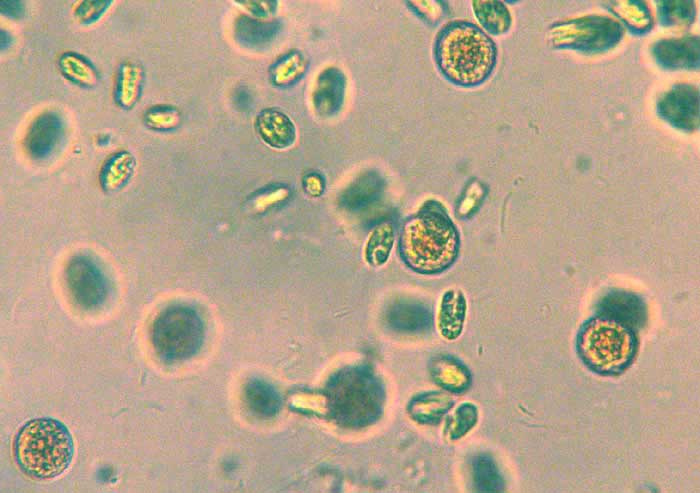Excerpts from Jim Conrad's
Naturalist Newsletter

from the February 9, 2014 Newsletter issued from the Frio Canyon Nature Education Center in the valley of the Dry Frio River in northern Uvalde County, southwestern Texas, on the southern border of the Edwards Plateau; elevation ~1750m (~5750 ft); N29.62°, W99.86°; USA
CHLAMYDOMONAS ALGA
While scanning through the galaxy of green Chlamydomonas cells I came upon a cluster of reddish items looking very much like red blood cells, or erythrocytes, as shown above.
Once again I had to resort to the identification technique of browsing thumbnail images summoned through Google's image-search feature, this time using the keywords "algae unicellular freshwater reddish." Though amateurish, this technique can be surprisingly useful. Within seconds a good match appeared, a picture of HAEMATOCOCCUS PLUVIALIS.
Haematococcus pluvialis commonly occurs worldwide, except in Antarctica, and is found mostly in temporary pools of freshwater, so it's to be expected in our fishbowl of water from the Dry Frio River. Often the species may occur in a pool beside a stream but be absent from the stream itself. Most authors when describing the species' various temporary habitats don't fail to mention that "If you have a birdbath with water that has turned red you may find the green algae Haematococcus pluvialis." The species hasn't acquired a common name, so here we'll file it under "Birdbath Alga."
You might recall that the world of algae is divided into large groupings such as the green algae, brown algae, diatoms and red algae. Our Birdbath Alga, despite its reddish color in our picture, is a green alga, which means it's a member of the Division Chlorophyta. Its chloroplasts often turn red when conditions become unfavorable, so apparently our cells feel stressed in the windowsill fishbowls. I read that they don't like bright light, so that may be what's turning them red.
As with the smaller, greener Chlamydomonas algae surrounding our Birdbath Alga's cells, Birdbath Alga cells are equipped with two hairlike flagella which when wiggled enable the cells to move about, but -- also as with the Chlamydomonas -- under our light microscope the flagella remain invisible.
If you Google Haematococcus pluvialis you'll find many pages of companies selling extracts made from it. That's because the species contains high concentrations of the strong antioxidant astaxanthin, which is especially important in aquaculture (as fish feed), and cosmetics. The reddish tint of shrimp, salmon, crawfish, crabs and lobster is caused by astaxanthin. In living organisms, because of its antioxidant properties, astaxanthin may play a key role in the protection of cell membranes against free radical attack.
In Amazon.com's online "Health & Personal Care Department," you can buy a bottle of 120 Softgel pills labeled as Astaxanthin and containing astaxanthin extracted from Birdbath Alga. It costs $18.95.